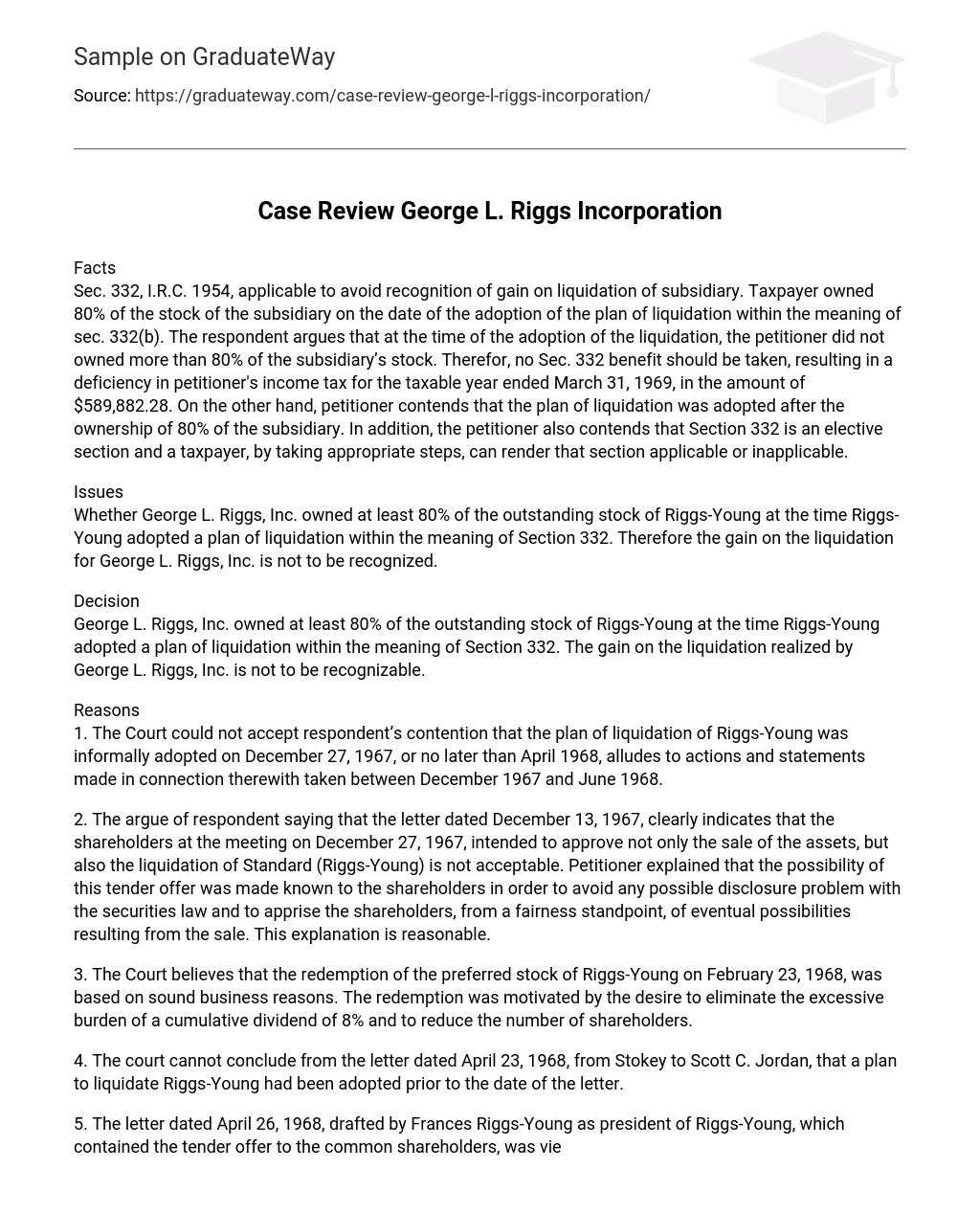Facts
Sec. 332, I.R.C. 1954, applicable to avoid recognition of gain on liquidation of subsidiary. Taxpayer owned 80% of the stock of the subsidiary on the date of the adoption of the plan of liquidation within the meaning of sec. 332(b). The respondent argues that at the time of the adoption of the liquidation, the petitioner did not owned more than 80% of the subsidiary’s stock. Therefor, no Sec. 332 benefit should be taken, resulting in a deficiency in petitioner’s income tax for the taxable year ended March 31, 1969, in the amount of $589,882.28. On the other hand, petitioner contends that the plan of liquidation was adopted after the ownership of 80% of the subsidiary. In addition, the petitioner also contends that Section 332 is an elective section and a taxpayer, by taking appropriate steps, can render that section applicable or inapplicable.
Issues
Whether George L. Riggs, Inc. owned at least 80% of the outstanding stock of Riggs-Young at the time Riggs-Young adopted a plan of liquidation within the meaning of Section 332. Therefore the gain on the liquidation for George L. Riggs, Inc. is not to be recognized.
Decision
George L. Riggs, Inc. owned at least 80% of the outstanding stock of Riggs-Young at the time Riggs-Young adopted a plan of liquidation within the meaning of Section 332. The gain on the liquidation realized by George L. Riggs, Inc. is not to be recognizable.
Reasons
1. The Court could not accept respondent’s contention that the plan of liquidation of Riggs-Young was informally adopted on December 27, 1967, or no later than April 1968, alludes to actions and statements made in connection therewith taken between December 1967 and June 1968.
2. The argue of respondent saying that the letter dated December 13, 1967, clearly indicates that the shareholders at the meeting on December 27, 1967, intended to approve not only the sale of the assets, but also the liquidation of Standard (Riggs-Young) is not acceptable. Petitioner explained that the possibility of this tender offer was made known to the shareholders in order to avoid any possible disclosure problem with the securities law and to apprise the shareholders, from a fairness standpoint, of eventual possibilities resulting from the sale. This explanation is reasonable.
3. The Court believes that the redemption of the preferred stock of Riggs-Young on February 23, 1968, was based on sound business reasons. The redemption was motivated by the desire to eliminate the excessive burden of a cumulative dividend of 8% and to reduce the number of shareholders.
4. The court cannot conclude from the letter dated April 23, 1968, from Stokey to Scott C. Jordan, that a plan to liquidate Riggs-Young had been adopted prior to the date of the letter.
5. The letter dated April 26, 1968, drafted by Frances Riggs-Young as president of Riggs-Young, which contained the tender offer to the common shareholders, was viewed by respondent as an additional indication of a prior adoption of a plan to liquidate.
The Court believes that the tender offer to the minority shareholders was made solely for business considerations. The primary purpose of the tender offer was to eliminate minority shareholders who might have different investment objectives for company’s assets than the majority shareholder, to decrease the number of minority shareholders, to have the minority shareholders receive cash for their stock rather than have them remain locked in a personal holding company, and to increase petitioner’s ownership of Riggs-Young to 80% thereby enabling them to file a consolidated return.





